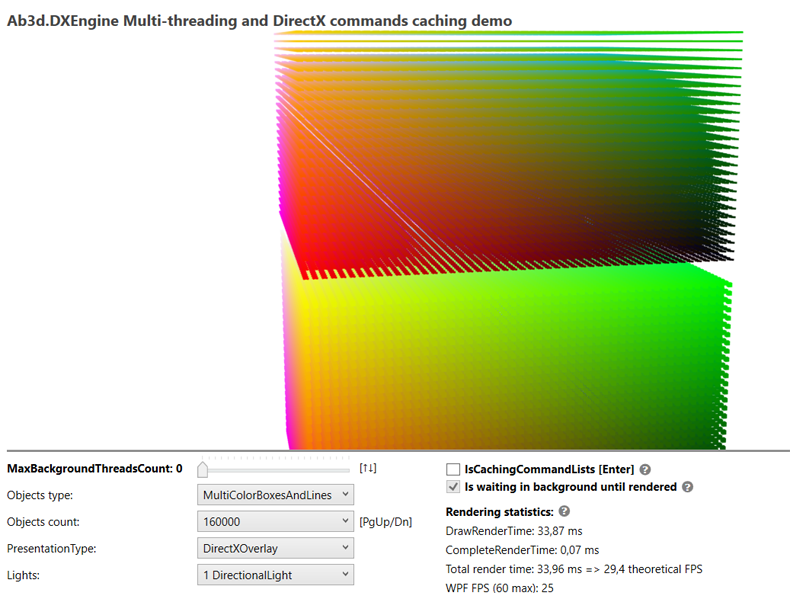New maintenance release for Ab3d.PowerToys and Ab3d.DXEngine has been published.
The new version does not come with any bigger new features and only brings a few fixes and improvements. Because of this, only the build version was increased, but the major and minor versions remained the same.
This version also comes with a new build for .Net 8.0. .Net 8.0 that was released a few days ago. At that point, I would like to thank the .Net team, which is doing a great job with each new .Net release. For example, the last version again came with many new performance improvements - see the article about that: Performance Improvements in .NET 8. This means that without any changes in the code, your code will run faster just by using the latest version of .Net.
I did a quick performance test by running the DXEngine multi-threading sample in .Net framework 4.8 and then in .Net 8.0. I used only single-threaded rendering with disabled commands caching and by showing 160.000 3D boxes and 3D lines. This means that for each frame the engine needed to set shader states and issue 160.000 draw calls. The results were astonishing. When running in .Net framework 4.8, the code required around 47 ms to render one frame. But when using .Net 8.0, only around 33 ms was needed for the same job. This is a 30% performance improvement.

The new version also comes with an updated Assimp importer. There is a new native Assimp library (v5.3.1) and a new managed Ab3d.PowerToys.Assimp library. Using a newer native library provides a more accurate importer and can read more files correctly. On top of that the Ab3d.PowerToys.Assimp was also improved. This version adds support for reading files with non-ASCII file names. Also, now it is possible to read diffuse textures with emissive materials. And in case you were using hardcoded object names, then I need to inform you that the new version also comes with a breaking change because the new version may set the object names differently. The latest version tries to use names so that they are as close to the original name as possible. In case when an object group also defines its own meshes, the previous version set the name of the Model3DGroup by adding the "__Group" suffix. The new version set the Model3DGroup's name to the original name without any suffix. To prevent using duplicate names, it adds a mesh name as a suffix to the GeometryModel3D's name that is added as a child of the Model3DGroup. If you want to preserve the previous naming, then set the PreserveGroupNames property to false. Note, then in WPF, an object's name must start with a letter or underscore and can contain only letters, digits, or underscores. Because of this, the object names may still be different from the original names in the file. For example, "12-material#10" would become "_12_material_10".
The updated Assimp importer files can found in the libs folder on GitHub.
To see the list of other fixes and changes, see the change log web pages: Ab3d.PowerToys history and Ab3d.DXEngine history.
As mentioned last week, when the new SharpEngine was released, I am planning to release a new major version of Ab3d.PowerToys and Ab3d.DXEngine at the end of Q1 2024 . The following are planned new features:
- Add support for Screen Space Ambient Occlusion (SSAO) - this can significantly improve the visual quality.
- Add new options to render pixels and point clouds (world-size pixels in addition to screen-size; render circular pixels or pixels with custom textures).
- Add support for rendering 3D lines and line segments to an object ID bitmap (can be used for faster line hit testing; especially for MultiLineVisual3D).
- Add options to copy only part of the object ID bitmap from GPU memory to CPU memory - this would make using ID bitmaps for hit objects much faster.
- Trying to improve the performance of calculating edge lines by using oct-tree.
For 2024, I would also like to introduce a new product that would allow importing 3D models from STEP and IGES file formats that are commonly used by CAD applications. Later, there would also be improved support for geometric and surface modeling that is based on mathematical surfaces and not triangles.
If you have any additional requests or wishes, please contact us. Otherwise, stay tuned.